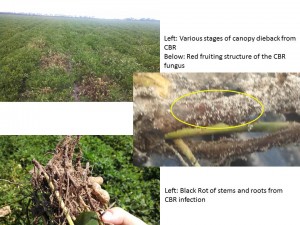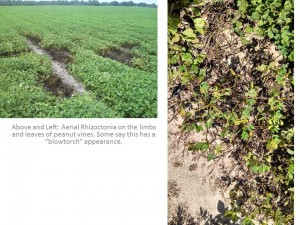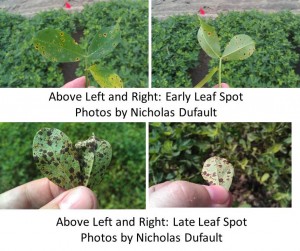Although things sound pretty quiet around the peanut belt from a disease standpoint, I would say that we are having a pretty active disease season locally. Most of the peanuts that I see are over 100 days old, with some at 135 days old this week. It seems to me disease control typically starts to slip around day 90. And much of the peanut belt just doesn’t have peanuts that old yet (as of writing).
There are a few unique concerns this season because of the cool wet conditions, some things that are the same as every year, and a few that we are on the lookout for moving ahead. I took a tour with Dr. Nick Dufault, UF Plant Pathologist on a route that eventually went through southen Columbia, Gilchrist, Lafayette, Suwannee, and back through middle Columbia County. While that sounds like alot of travel, I don’t think we covered 50 miles all day. I had a few “hotspots” in mind so instead of spending the day walking clean fields we focused on trouble spots.
 We are finding some CBR (Cylindrocladium Black Rot, Cylindrocladium parasiticum) around the area. Undoubtedly, a result of cool, wet conditions. This is on land that I would call well drained “peanut” soils. So it can happen on any of our soils. We are seeing the canopy thinning and can find the “brick-red” perithecia or fruiting structure of the fungus on the stems.
We are finding some CBR (Cylindrocladium Black Rot, Cylindrocladium parasiticum) around the area. Undoubtedly, a result of cool, wet conditions. This is on land that I would call well drained “peanut” soils. So it can happen on any of our soils. We are seeing the canopy thinning and can find the “brick-red” perithecia or fruiting structure of the fungus on the stems.
I have seen a few fields with issues from Rhizoctonia (Rhizoctonia solani). In one case this is the “Aerial Blight”, which looks like a blow torch has fried the vines. In another case it appears that every new peg is being damaged by disease as they enter the soil. Obviously this is challenging as there was only half a crop and a long season left. In even another field the root system appears to be failing from the disease.
In even another field the root system appears to be failing from the disease.
We can always find some white mold or stem rot (Sclerotium rolfsii) around and all of my peanut farmers are pretty comfortable with identification and management of this disease. In some cases where we still do not have good control more night sprays are going out with a different fungicide mode of action.
Something that has been troublesome all season has been the diversity and frequency of “leaf spots.” We think many of these this year are related to chemical use and we certainly use our share of wild tank mixes of fungicide, herbicide, surfactants, and nutritionals around here. So it is hard to figure all the different spots that we are seeing. Dr. Dufault and I are in agreement that we need to be vigilant treating for late leaf spot (Circosporidium personatum)as we conclude this season. I have found one farm field that I think we are already in big trouble with late leaf spot. Many of our farmers have missed a spray due to 60 days of rain or they stretched a two week spray window to three. Leaf spot often lets you know that you left the door openfor disease before the season is over, even though you may not see it right away. Because leaf spot is so difficult to identify with all these other blemishes in the mix. I have attached a few pictures from Dr. Dufault as a reference.
While I feel like we are firmly on track to finish out this crop. I see another potential rainmaker in the forecast. Be aggressive to get “sprayed up” in case the next system from the gulf gives us an upper cut.
